外研版(2019)选择性必修第一册Unit2 Onwards and upwards Reading 课件(共26张PPT)
文档属性
| 名称 | 外研版(2019)选择性必修第一册Unit2 Onwards and upwards Reading 课件(共26张PPT) | 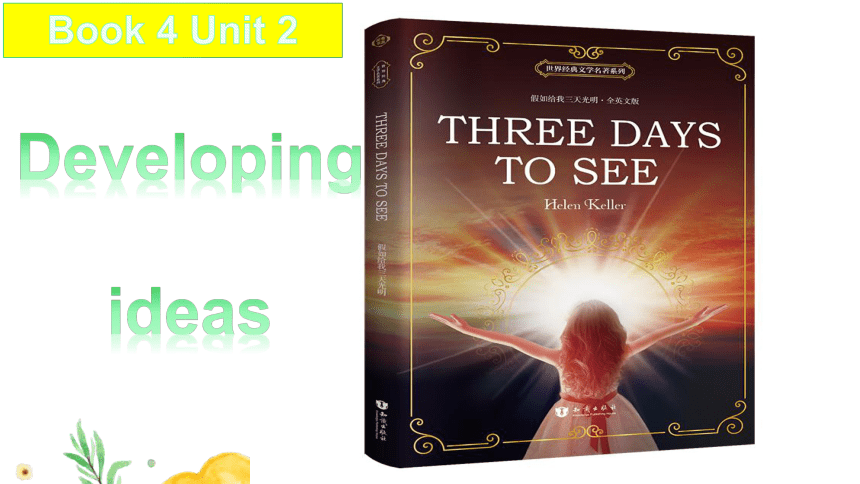 | |
| 格式 | pptx | ||
| 文件大小 | 2.7MB | ||
| 资源类型 | 教案 | ||
| 版本资源 | 外研版(2019) | ||
| 科目 | 英语 | ||
| 更新时间 | 2023-09-15 14:33:03 | ||
图片预览

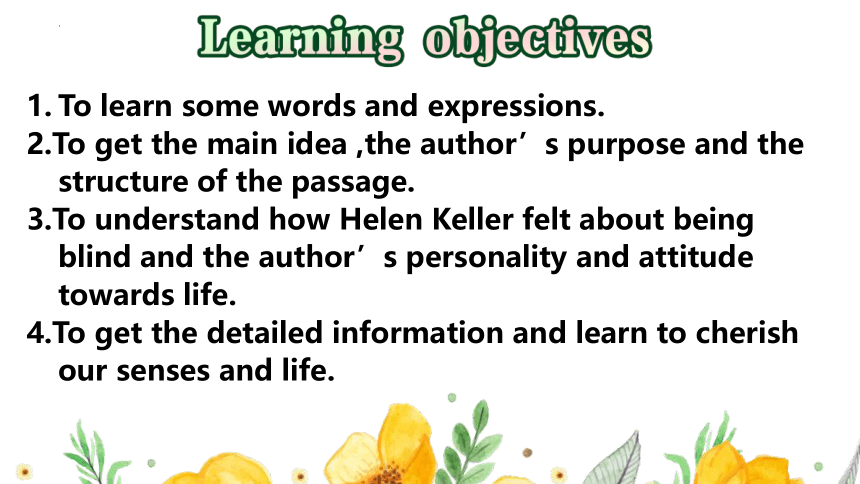
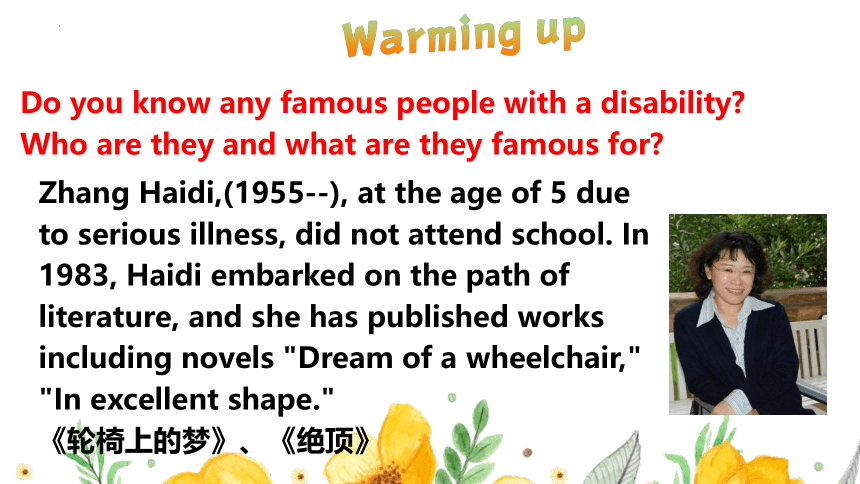
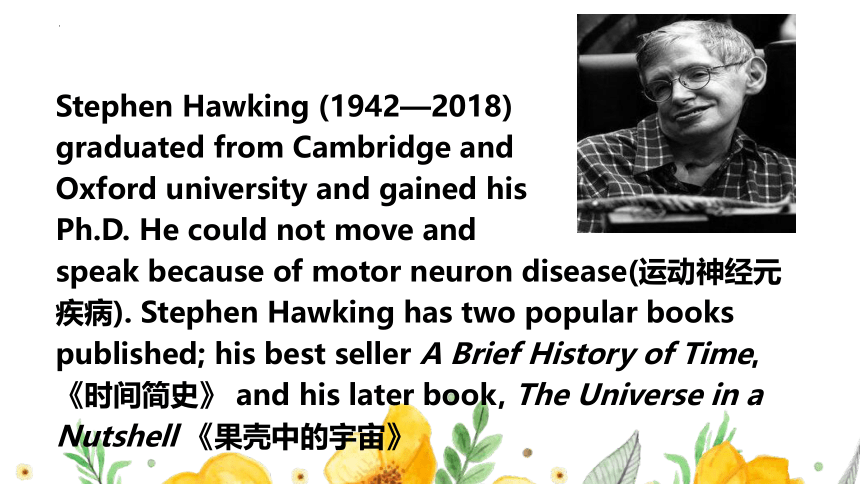
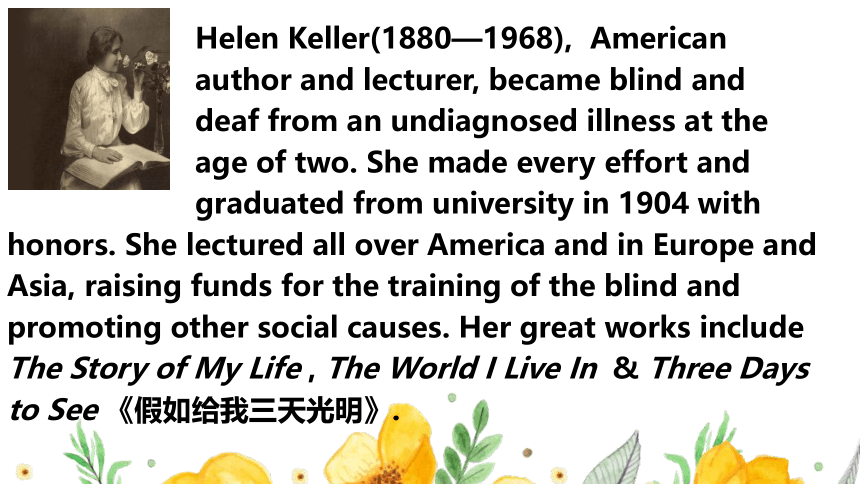


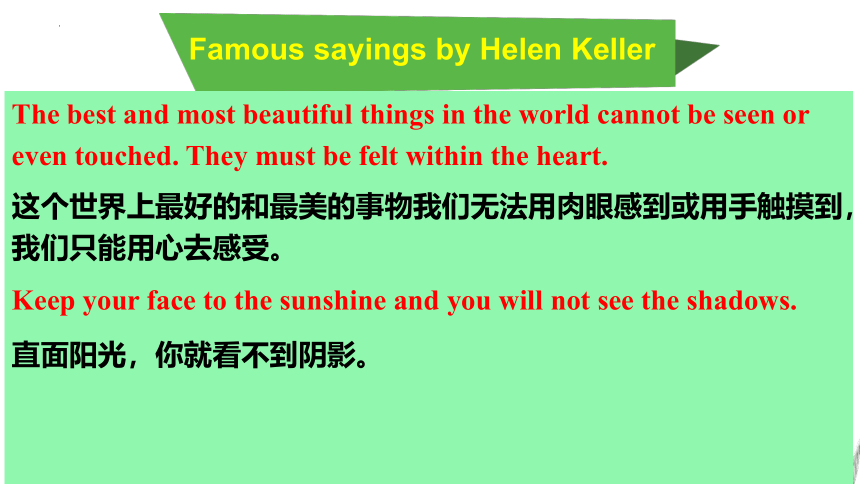
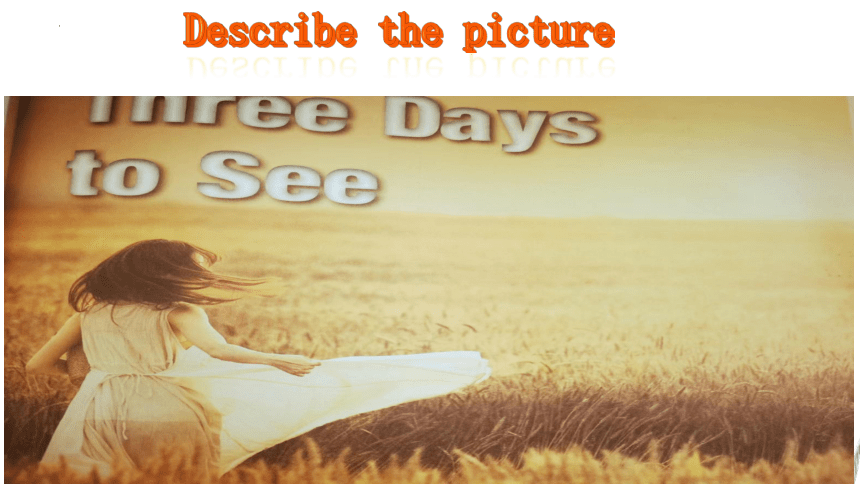
文档简介
(共26张PPT)
Book 4 Unit 2
Developing
ideas
To learn some words and expressions.
2.To get the main idea ,the author’s purpose and the structure of the passage.
3.To understand how Helen Keller felt about being blind and the author’s personality and attitude towards life.
4.To get the detailed information and learn to cherish our senses and life.
Do you know any famous people with a disability
Who are they and what are they famous for
Zhang Haidi,(1955--), at the age of 5 due to serious illness, did not attend school. In 1983, Haidi embarked on the path of literature, and she has published works including novels "Dream of a wheelchair," "In excellent shape."
《轮椅上的梦》、《绝顶》
Stephen Hawking (1942—2018)
graduated from Cambridge and
Oxford university and gained his
Ph.D. He could not move and
speak because of motor neuron disease(运动神经元疾病). Stephen Hawking has two popular books published; his best seller A Brief History of Time, 《时间简史》 and his later book, The Universe in a Nutshell 《果壳中的宇宙》
Helen Keller(1880—1968), American
author and lecturer, became blind and
deaf from an undiagnosed illness at the
age of two. She made every effort and
graduated from university in 1904 with honors. She lectured all over America and in Europe and Asia, raising funds for the training of the blind and promoting other social causes. Her great works include The Story of My Life , The World I Live In & Three Days to See 《假如给我三天光明》.
Works by Helen Keller
More Information about Helen Keller
Portrait of Helen Keller when she was 7.
Helen Keller & Anne Sullivan
It is a writing of Helen Keller when she was 7. There are many words on the paper.
Famous sayings by Helen Keller
The best and most beautiful things in the world cannot be seen or even touched. They must be felt within the heart.
这个世界上最好的和最美的事物我们无法用肉眼感到或用手触摸到,我们只能用心去感受。
Keep your face to the sunshine and you will not see the shadows.
直面阳光,你就看不到阴影。
Describe the picture
Tasks:
1.The main idea of the passage
2.The author’s purpose
3.The structure of the passage
Go through the passage and find out the information on these tasks.
Fast
the main idea
In paragraph 3:
What I should like to see if I were given the use of my eyes,say for just three days
Task 1
Choose the author's purpose in writing the passage and give your reasons.
1. To help readers understand what it is like to be blind.
2.To make readers without disabilities appreciate what they have.
3. To persuade readers to care about the blind.
Task 2
Task 3
the structure
Para1-Para 3 Many people without a disability are not appreciative of what they have.
Para4-Para 7 What Helen should like to see if she were given three days to see
Para8 She offers people a hint.
Answer questions:
1.What might Helen feel when her friend replied “nothing in particular”
2.What should Helen want to see if she were given 3 days to see
3.What does Helen value most Give your reasons.
4.What kind of person is Helen according to the passage
Further
Answer questions:
1.What might Helen feel when her friend replied “nothing in particular”
She might feel shocked.
She might feel terribly sorry for her friend.
Further
Answer questions:
2.What should Helen want to see if she were given 3 days to see
Further
On the first day
On the second day
On the third day
She would want to see the kind people who have helped her and accompanied her through life. Then she would like to see the books which have opened her mind, in the afternoon, she would take a long walk in the woods and appreciate the beauty of nature.
She would like to see a display of the progress of civilization. She would go to the museums and spend the evening at a theater or at the movies.
She would again greet the dawn, anxious to discover new delights, new revelations of beauty. She would spend the third day observing people in their day-to-day life.
Answer questions:
2.What should Helen want to see if she were given 3 days to see
She should like to see every aspect of the world,including the people,the books,the beauties of nature,the history and culture,the daily routines...
Further
Answer questions:
3.What does Helen value most Give your reasons.
The people who loved and helped her.
She wanted to see the people on the first day.
Further
Answer questions:
4.What kind of person is Helen according to the passage
She stays positive to life.
She is grateful to people who help her.
She cherishes truth and human civilization.
She loves nature and life.
She has social responsibility.
Further
1. What sentence structure is used repeatedly What figure of speech is it
A similar structure is used repeatedly. Namely, “Use…as if…Hear…as if…Touch…as if…”. It is parallelism.
2. How does this technique help to express the author's emotions
The use of parallelism in speech or writing allows speakers or writers to maintain a consistency within their work and creates a balanced flow of ideas. Moreover, parallelism can be used as a tool for persuasion.
What is parallelism
What’s the function of parallelism
Parallelism as literary device is the use of expressions, clauses or sentences that are similar in their structure.
It can make the content more rhythmic, engaging and easier to remember. It is commonly used in works and speeches.
Now make your own sentences using this technique.
Work in groups. Give a talk about your opinion on the sentence from the passage.
… it would be a blessing if each human being were stricken blind and deaf for a few days at some time during his early adult life.
Read and discuss the meaning of the sentence and decide whether you agree or disagree with it.
e.g. I think it means that we can only appreciate things after we lose them and I totally agree with it.
1. Read the passage at least three times.
2. Try to recite last paragraph.
3.What can you do to make your life more valuable and meaningful (at least 5 things to do)
See you.
Thank you very much
THANK YOU FOR WATCHING
Book 4 Unit 2
Developing
ideas
To learn some words and expressions.
2.To get the main idea ,the author’s purpose and the structure of the passage.
3.To understand how Helen Keller felt about being blind and the author’s personality and attitude towards life.
4.To get the detailed information and learn to cherish our senses and life.
Do you know any famous people with a disability
Who are they and what are they famous for
Zhang Haidi,(1955--), at the age of 5 due to serious illness, did not attend school. In 1983, Haidi embarked on the path of literature, and she has published works including novels "Dream of a wheelchair," "In excellent shape."
《轮椅上的梦》、《绝顶》
Stephen Hawking (1942—2018)
graduated from Cambridge and
Oxford university and gained his
Ph.D. He could not move and
speak because of motor neuron disease(运动神经元疾病). Stephen Hawking has two popular books published; his best seller A Brief History of Time, 《时间简史》 and his later book, The Universe in a Nutshell 《果壳中的宇宙》
Helen Keller(1880—1968), American
author and lecturer, became blind and
deaf from an undiagnosed illness at the
age of two. She made every effort and
graduated from university in 1904 with honors. She lectured all over America and in Europe and Asia, raising funds for the training of the blind and promoting other social causes. Her great works include The Story of My Life , The World I Live In & Three Days to See 《假如给我三天光明》.
Works by Helen Keller
More Information about Helen Keller
Portrait of Helen Keller when she was 7.
Helen Keller & Anne Sullivan
It is a writing of Helen Keller when she was 7. There are many words on the paper.
Famous sayings by Helen Keller
The best and most beautiful things in the world cannot be seen or even touched. They must be felt within the heart.
这个世界上最好的和最美的事物我们无法用肉眼感到或用手触摸到,我们只能用心去感受。
Keep your face to the sunshine and you will not see the shadows.
直面阳光,你就看不到阴影。
Describe the picture
Tasks:
1.The main idea of the passage
2.The author’s purpose
3.The structure of the passage
Go through the passage and find out the information on these tasks.
Fast
the main idea
In paragraph 3:
What I should like to see if I were given the use of my eyes,say for just three days
Task 1
Choose the author's purpose in writing the passage and give your reasons.
1. To help readers understand what it is like to be blind.
2.To make readers without disabilities appreciate what they have.
3. To persuade readers to care about the blind.
Task 2
Task 3
the structure
Para1-Para 3 Many people without a disability are not appreciative of what they have.
Para4-Para 7 What Helen should like to see if she were given three days to see
Para8 She offers people a hint.
Answer questions:
1.What might Helen feel when her friend replied “nothing in particular”
2.What should Helen want to see if she were given 3 days to see
3.What does Helen value most Give your reasons.
4.What kind of person is Helen according to the passage
Further
Answer questions:
1.What might Helen feel when her friend replied “nothing in particular”
She might feel shocked.
She might feel terribly sorry for her friend.
Further
Answer questions:
2.What should Helen want to see if she were given 3 days to see
Further
On the first day
On the second day
On the third day
She would want to see the kind people who have helped her and accompanied her through life. Then she would like to see the books which have opened her mind, in the afternoon, she would take a long walk in the woods and appreciate the beauty of nature.
She would like to see a display of the progress of civilization. She would go to the museums and spend the evening at a theater or at the movies.
She would again greet the dawn, anxious to discover new delights, new revelations of beauty. She would spend the third day observing people in their day-to-day life.
Answer questions:
2.What should Helen want to see if she were given 3 days to see
She should like to see every aspect of the world,including the people,the books,the beauties of nature,the history and culture,the daily routines...
Further
Answer questions:
3.What does Helen value most Give your reasons.
The people who loved and helped her.
She wanted to see the people on the first day.
Further
Answer questions:
4.What kind of person is Helen according to the passage
She stays positive to life.
She is grateful to people who help her.
She cherishes truth and human civilization.
She loves nature and life.
She has social responsibility.
Further
1. What sentence structure is used repeatedly What figure of speech is it
A similar structure is used repeatedly. Namely, “Use…as if…Hear…as if…Touch…as if…”. It is parallelism.
2. How does this technique help to express the author's emotions
The use of parallelism in speech or writing allows speakers or writers to maintain a consistency within their work and creates a balanced flow of ideas. Moreover, parallelism can be used as a tool for persuasion.
What is parallelism
What’s the function of parallelism
Parallelism as literary device is the use of expressions, clauses or sentences that are similar in their structure.
It can make the content more rhythmic, engaging and easier to remember. It is commonly used in works and speeches.
Now make your own sentences using this technique.
Work in groups. Give a talk about your opinion on the sentence from the passage.
… it would be a blessing if each human being were stricken blind and deaf for a few days at some time during his early adult life.
Read and discuss the meaning of the sentence and decide whether you agree or disagree with it.
e.g. I think it means that we can only appreciate things after we lose them and I totally agree with it.
1. Read the passage at least three times.
2. Try to recite last paragraph.
3.What can you do to make your life more valuable and meaningful (at least 5 things to do)
See you.
Thank you very much
THANK YOU FOR WATCHING
